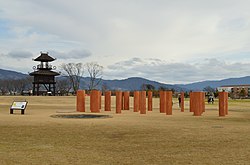唐古・鍵遺跡 | |
 | |
 |
The Karako-Kagi Site is an archaeological site in Tawaramoto, Nara Japan. [1] It has a metallurgical facility, and is near other sites such as the Makimuku ruins. [1] Chicken breeding is known from the site. [2] [3] [4] [5] However no rice paddy fields are associated with it. [6]
